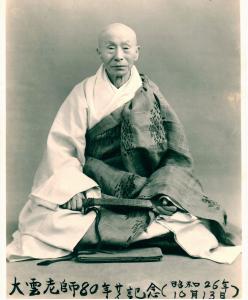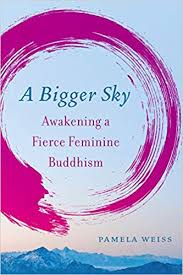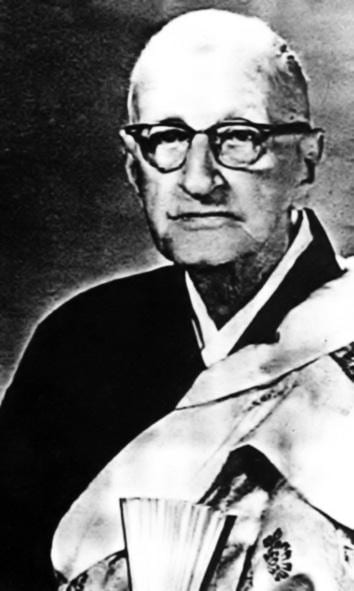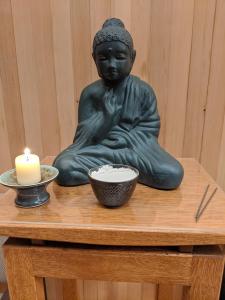Daiun Sogaku Harada died on this day, the 12th of December in 1961.
He was born in Obama, Fukui Prefecture on the 13th of October, 1871. Sogaku was tonsured as a Soto monastic at the age of 7. At twenty he entered the Rinzai monastery, Shogenji, where he had several openings. He also studied at the historic Soto affiliated Komazawa University.
Sogaku Harada received Dharma transmission within the Soto school from Harada Sodo Kakusho.
He taught at Komazawa for twelve years before assuming full time responsibilities as abbot of his own monastery, Hosshinji, which he served for forty years. The monastery was famous for its harsh location on the Japan sea, with as Wikipedia tells us, hard rains, snow storms, and even typhoons.
In his training he studied with a number of Soto & Rinzai masters including Harada Sodo Kakusho, his ordination master, Oka Sotan, Akino Kodo, Adachi Tatsujun, Hoshimi Tenkai, Unmuken Taigi Sogon, and critically Kogenshitsu Dokutan Sosan.
There is debate within the Zen community as to whether he actually received dharma transmission from Dokutan Roshi. I was told by Maezumi Roshi that while Dokutan Roshi considered Harada Roshi to have completed all necessary training with him to be an independent master of the koan way, there was no formal transmission. In that time and place such a formal recognition would have also had Harada leave the Soto school, something that he had no desire to do.
Harada Roshi was a prominent figure within the Soto church. And he has been criticized, and I think justly, for his fervent support of Japanese nationalism in the years running up to and through the Second World War. A caution, I feel, for all of us as we necessarily engage the cultures within which we live.
The Roshi’s most important contribution for us in the West his without a doubt his reformation of the koan training program he had inherited from Dokutan Roshi. His program began in the same way as the Rinzai system he learned, with a dharmakaya koan, almost always Mu.
This was followed by a number of questions deepening insight into the nature of emptiness and our intimate relationship within and as emptiness. Then moving on to a short-course of brief koans that familiarize the student with the nuances of koan introspection practice, introducing standard tropes, and the form of the dance.
After that he continued the normative Rinzai style within the Takujo school, of taking on the tradition book the Gateless Gate and the Blue Cliff Record. After that he diverged from Rinzai practice, substituting two classic Soto koan collections for the two used within Rinzai. And then at the end of the curriculum, he reversed the received order, going first to the Goi koans before “concluding” with the precepts as koan.
There were other modifications, most notably dropping the capping phrase component that had evolved within Rinzai. While, instead, offering occasions to revisit the original use of spontaneous appreciations of particular cases.
This reformed curriculum would become the standard transmitted to the West by the lay community, Sanbo Zen (originally Sanbo Kyodan), and through successor organizations like the Diamond Sangha, Pacific Zen Institute, and Boundless Way. It also was continued through the priestly transmission in the White Plum Asangha. Most likely if one encounters a koan teacher in the West, that person will stand within Harada Roshi’s lineage.
While I received my priestly training and authorization from Houn Jiyu Kennett, it was my training in this koan curriculum with John Tarrant, an heir in this lineage that genuinely opened my heart and allowed me to become the person I am today. I cannot say how much I owe to the Roshi and the tradition that flows from his teachings.
Endless bows…













